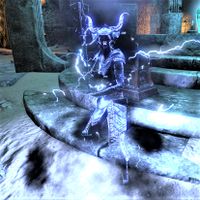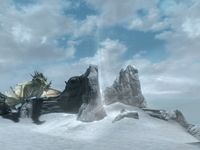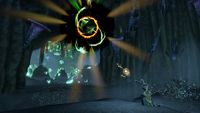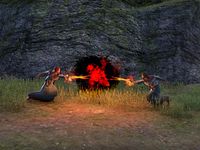Lore:Dragon Break
—Where Were You When the Dragon Broke?
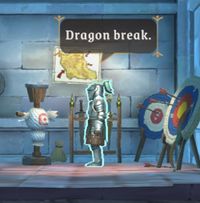
A Dragon Break is a phenomenon where linear time is broken, and becomes non-linear. The "Dragon" refers to Akatosh, the Dragon God of Time. A Dragon Break not only precedes significant changes in Tamriel, but challenges mortal comprehension.[1] Described as a "catastrophic disruption of linear time", it is a re-alignment of time and space in response to an event that makes the normal continuity of reality impossible.[2] The chaos that ensues is a refrain of the chaos of the Dawn Era.[3] The area that is noticeably affected, and length of the interval measured in the areas not apparently affected, varies with each Dragon Break. Historically, the cause is often attributed to mortals manipulating divine matters.[1][4]
Known Breaks[edit]
The Middle Dawn[edit]
A sect of the Alessian Order, the Marukhati Selective, is said to have caused the longest known Dragon Break—known as the Middle Dawn (or, colloquially, as "the" Dragon Break)—which is thought to have spanned one thousand and eight years,[1][5] from the 13th to the 23rd centuries in the First Era.[UOL 1] The Selectives believed that Akatosh, the Supreme Spirit—of "unitary essence" and originally a spirit of "humanadic purity"—had been subject to the insertion of an "Aldmeri taint" and needed to be "restored" to its pure state via the elimination of the elements of Elven Auriel from Imperial Akatosh—an act they called the "Sacred Expungement". In attempting to enact the Expungement through the use of the Staff of Towers, the Selectives damaged the fabric of time and caused the Middle-Dawn Dragon Break.[6][7] The Psijic Loremaster Celarus claimed that misuse of the Staff of Towers had played a part in bringing about the Dragon Break, although he did not specify by whom. According to Celarus, Dragon Breaks could be created by the "impossibly dense Aurbic gyre" formed by the coalescence of the Staff's power.[2] This is the only Dragon Break that is a universally-known event, though some civilizations claim to have been protected from it through the intervention of a number of Daedric Princes.[1] Mnemoli the Blue Star, a Magna Ge associated with un-time events, grew bright enough during this Dragon Break to be seen in the daytime sky.[8]
One pre–Riddle'Thar-Epiphany Khajiit account describes how, during the Middle-Dawn, Boethra was called from her battle with Orkha by the Blue Star and transported atop the Adamantine Tower by Khenarthi. There, Boethra saw the Selectives speaking lies in a way that made them true, drawing runes in an attempt to realize a world wherein neither Akha, nor Alkosh, nor Alkhan, nor any Child of Akha, nor any of the myriad kingdoms Akha had created along the Many Paths—any of the lands he'd seeded and brought into his kingdom—had ever existed. Seeing the lie the Selectives were attempting to make real, Boethra—who had once been exiled to the Many Paths by Akha—began to wonder if she had ever been the Daughter of Blades at all, or if it had all been merely the dream of someone who had never even existed; and, so-thinking, felt something akin to fear for the first time. Knowing they must not succeed, Boethra first calculated, and then enacted, the cuts needed to destroy both the Selectives and the alternative history they had attempted to make real. Then, sensing that their actions had created an opportunity, she found a "tunnel" to the fate they'd sought, and opened her eyes to behold twelve spinning wheels surrounded by fire, revolving beneath two warring serpents: one a serpent of flaming feathers and crystal scales, with a head like a hunting bird; and the other a crimson-eyed serpent of black scales and white mane, followed by all the Void—somehow (in the Khajiit account) representing the "truth within the lies" of the Selectives. While the flame-feathered serpent emanated rejection of all "Mannish impurity in all the known worlds", the dark serpent—though surrounded by chaos—emanated gentleness and love for the spirits of the worlds; and in it, Boethra saw a fleeting chance for peace. As the feathered serpent's beak found purchase beneath the scales of the white-maned serpent, Boethra, dodging through the wheels to reach, summoned her blades and struck at its eye, repelling it. Landing on the head of the dark serpent, she drew upon its black flames, forming a blade and armor as her mind was scorched with things that were and things that had yet to be. She named the hawk-serpent "for what it was" and—reciting the "Will Against Rule"—dashed forward, cutting concepts at strange angles and thereby (in some unknown way) ending the Dragon Break. This event would later come to be known as the Division of Heaven by mortals who remembered the Middle-Dawn.[9]
Yet, in later eras, the occurrence of this event became disputed; most notably, by the scholar Fal Droon. He posited that no cosmic disruption took place at all, and that the "Dragon Break" story was concocted in the early Third Era to explain inconsistencies in the Encyclopedia Tamrielica. He cites "scholarly inertia", obsession with "eschatology", and fanatical "Numidiumism" in order to explain the perpetuation of the error.[5]
Fal Droon's claim that the Dragon Break was a Third Era fabrication is apparently discredited by older sources, which are known to have described the Dragon Break as early as 2E 582.[10] In particular, Vindication for the Dragon Break seems to describe the Marukhati Selective's justification for the Middle Dawn before the event itself. The Dunmer of the era were hostile towards the Empire,[11] yet they still acknowledge a Dragon Break occurred.[1] Furthermore, a member of the Elder Council claimed that the oversoul of emperors within the Amulet of Kings confirmed that a Dragon Break took place. The Council purportedly gathered information from every province. However, they only offered stories that never coincide except in mentioning that all the folk of the continent tracked the fall of eight stars, which they used to count their days.[1]
An abstruse text ascribed, like the Vindication, to Arch-Prelate Fervidius Tharn appears to describe the mechanics of the Middle Dawn in more detail as involving the detachment of a particular "sheath" from the "integument", or outer layer, of the Aurbis. This process would begin by "intercourse with the star-orphan" Mnemoli, followed by "eversion of the organ of thought" and "an employment of the Hurling Disk", "twisting the enveloping sheath into the middle dawn".[12]
Rubble Butte[edit]
Circa 2E 582, the Breton noblewoman Lady Edwyge stole a copy of the text Vindication for the Dragon Break from the Mages Guild in Hallin's Stand. She managed to convince an Orc novice named Gahgdar to let her borrow the book, and then fled to the ruins of Rubble Butte, an ancient Ayleid complex located near Nilata in southern Bangkorai. She and her supporters sought to turn back time several years in order to change the course of history and ensure Edwyge became Queen of Bangkorai rather than Arzhela. The nobles managed to emulate the ritual performed by the Marukhati Selective and turned back time a few hours, but ended up creating a time trap within the ruins by trying to extend the ritual further.[13]
Unbeknownst to the nobles, Gahgdar had tracked Edwyge down to Rubble Butte and had entered the ruins in search of the book to avoid being kicked out of the Guild. However, he also became stuck in the time trap. The Vestige subsequently entered Rubble Butte and agreed to help Gahgdar recover the book from the nobles. The Vestige fought through the nobles before reaching Lady Edwyge and killing her, recovering the book in the process. However, upon reading Edwyge's notes, it transpired that she had anticipated her death and was stuck reliving the same few hours over and over again. The Vestige returned the book to Gahgdar, but the cycle simply began anew; Gahgdar would repeatedly request the recovery of the book, and Edwyge and her supporters would repeatedly be slain in order to recover it.[14] The Vestige was not caught in the time trap and was free to leave Rubble Butte, but the ultimate fate of those trapped inside is unknown.
The Brass God[edit]
The first activation of Numidium by Tiber Septim at the town of Rimmen in Elsweyr is said to have preceded a Dragon Break that heralded the Third Empire.[1][5] The second activation of Numidium in the Iliac Bay region during 3E 417 brought about another Dragon Break. Sentinel, Wayrest, Daggerfall, Orsinium, and the Empire all gained control of the Totem of Tiber Septim, somehow at the exact same time, which allowed them to control the power of the golem. When this "Warp in the West" ended (the effect objectively seemed to last roughly two days), the many other kingdoms of the Iliac Bay region were conquered. Each remaining kingdom consolidated its newfound territory and swore fealty to the Empire, bringing historically unusual harmony to northwestern Tamriel.[4]
Because the use of Numidium has not once, but twice been associated with a Dragon Break, it is speculated that some of the events surrounding the Battle of Red Mountain and the disappearance of the Dwemer around 1E 700 may also be explained by a Dragon Break.[1] This purported Dragon Break, sometimes called the Red Moment,[15][UOL 2] involved the battle that ultimately resulted in the disappearance of the Dwemer.[16][17] The accounts of this battle often conflict with each other on various points, such as the loyalties of the parties in the battle and the events, which transpired at the climax of the battle, including how the Dwemer met their fate.[16][17][18][19]
Effects[edit]
While it is said no mortal truly understands what happened within the bounds of the Middle-Dawn, accounts gathered by the Elder Council describe certain phenomena that allegedly occurred. Some Cyrodiilic accounts from the souls of the emperors in the Amulet of Kings describe how Cyrodiil became an empire across the stars, while others describe it becoming an egg. Dunmer accounts describe eight stars falling to Tamriel and borders constantly shifting as the Three Good Daedra and the House of Troubles came together to protect Morrowind from the madness. Khajiit accounts claim that the Moons were the only constant in the heavens but only the Khajiit could see because of their use of Moon Sugar, allowing them to record events while others warred with phantoms and gave birth to their own fathers, they also reference the future use of the Numidium at Rimmen as well as the Warp in the West, which wouldn't occur until the Third Era. Mannimarco describes how his location, like that of all mortals, shifted during the Break.[1]
Accounts of the Warp in the West describe mass disappearances with whole armies suddenly being transported hundreds of miles away, titanic storms, celestial phenomena, discontinuities of time where whole days and their events are "lost" except for a few who still experienced them, and great swathes of land being scorched and left in ruins, culminating in the overnight transformation of the kingdoms of the Iliac Bay.[4]
Time Wounds[edit]
Time Wounds, also known as Tiid-Ahraan in the Dragon Language, are tears created in the fabric of space when time is shattered within a localized area. These distortions of time and space have some similarities to Dragon Breaks. In appearance they can resemble a slight shimmering in the air, or a vortex of golden and purple light.
Time Breaches[edit]
Time Breaches are small tears in the fabric of time, which are invisible to mortal eyes. Powerful Time Magic like that of the Psijic Order allows one learn the approximate location of a Breach, but only gazing through a being with a different perception of time and space like the Augur of the Obscure will allow a mortal to accurately track them,[20] or peer through the veil and see them.[2] The influence of relics such as the Staff of Towers, even fragmented, can cause clusters of these Breaches to manifest in various locations across the land, producing raging time-storms that can keep occuring even if the cause is removed from that plane.[2] The Breaches can be sealed through the use of Psijic Seals, arcane anchors created by the ancient Aldmer who sought to bind any wayward spirits or forces in a given place during a time when the veil was thinner,[20] which allow the wielder to stabilize the rifts and harden the walls of time that surround them through the use of "chrononymics". If Time Breaches are allowed to remain, then the temporal energies will accumulate, eventually coalescing into an "impossibly dense Aurbic gyre", which is said can potentially create a new Dragon Break, break time, or worse.[2]
Proximity to either potent arcane structures such as the Towers or mages of power great enough such as the elders of the Psijic Order, objects or beings that by their very existence exert tremendous stress on Aurbic forces around them and create arcane risk, can further destabilize Time Breaches, causing the temporal energies to spin out of control and consume those present.[2]
Attempting to use potent Time Magic to accomplish great changes like undoing events that have already occurred can cause multiple Time Breaches to manifest. Such an event occurred when the Psijic Josajeh attempted to use the Staff of Towers in the White-Gold Tower's Time-Lost Throne Room to undo the tragedies of her past. These Breaches allowed alternate timeline versions of Josajeh to manifest into the world.[21][20][22]
The Augur of the Obscure describes the Time Breaches as "chronosymphonic discs" and claims that should they remain unsealed the world would become one of non-linear time, making it possible for one to die before they were even born, though there was also a sixty percent chance that time would "fold inside out". According to the Augur there are creatures that can eat Time Breaches but a mortal shouldn't attempt it lest they be "sucked through their own bellybutton", nor even contemplate Breaches and non-linear time too long as even that can be dangerous.[22] Psijic Monks had the ability to use Time Breaches to springboard to a different time and place.[2]
Time Knots[edit]
Time Knots are temporal distortions described as eddies in the stream of time that disrupt it's flow within a certain area and are capable of altering causality. If time is likened to a woven fabric with threads that cross and stitch together, than a Knot is what occurs when those threads bind together unnaturally, threads of chance and potential tangling around a single point. They can manifest for a variety of reasons, including powerful spells, the activation of arcane relics, Daedric trickery, or even naturally without external influence. Whatever the cause, creating a Time Knot requires a great deal of power. An area enveloped by the influence of a Time Knot will be trapped within a repeating time loop and, if left unattended, a Knot can also grow to encompass larger areas.[23][24]
A Time Knot can be unraveled through the use of Time Magic like that employed by the Psijic Order, whose members will seek out and dispel such distortions. A Knot created by a common cause can be relatively simple to dispel provided the mage has the required knowledge. However, there are Knots created by uncommon sources, which can be much harder to get rid of, distortions where too many threads are bound too tightly to one another, and can even have a will of their own, resisting attempts to unravel them.[23][24]
One such Knot enveloped the Telvanni township of Bal Sunnar, trapping it in a time loop from sometime after the Battle of Red Mountain to 2E 582 when it was undone by the Psijic Monk Saresea and the Vestige. The Knot was created by a Telvanni splinter group who sought to escape the rising rule of the Tribunal through the use of a Glyphic, an artifact of Hermaeus Mora. It is the physical manifestation of a Fate or knowledge and can be coaxed to transform into a tangible version of the concept it contains.[25] The Telvanni, recognized the Vestige and Saresea from previous loops and tried to stop them, tapping into the magic of the Knot to summon creatures from the time of ancient Nirn or to conjure temporal duplicates of themselves to aid them in combat. The Knot itself resisted Saresea, exploding outward and transporting her and the Vestige both to the distant past and the distant future.[23][24][26][27]
Ultimately Saresea and the Vestige succeeded in defeating the Telvanni Matriarch and dispelling the Knot but at a cost: Saresea was fragmented and scattered across time. Though Hermaeus Mora, who had been observing, reached out and pulled her back together she remained "multichronal", a being that manifests at multiple points in space and time simultaneously, both in the past and in the future, ranging from her own birth to her own death and beyond.[23][24]
The energies of a Time Knot can be drawn upon to empower someone, it is also possible for pieces of it to break off. Saresea claimed that contact with the Bal Sunnar Time Knot made her feel "all of time".[23][24]
Time Ripples[edit]
There have been cases of mages conducting rituals that caused their surrounding area to "ripple with temporal distortion", connecting different time periods and drawing beings from one into the other. While time was distorted in this manner interacting with objects with a strong link to the different time period had the potential to transport one through time to said period, expriencing that time's events by taking the place of the one the object was tied to originally.[28][29][30][31]
Notes[edit]
- Vivec's "Scripture of the Numbers" begins with "The Dragon Break, or the Tower. 1".[32]
- The Middle Dawn has been associated with the number 17 and the "Hurling Disk".[12]
- "Kalpas" are thought to be the overarching epochs into which the flow of time is divided, with the transition from the chaos of the Dawn Era to the Merethic marking the end of a previous kalpa.[33][UOL 3] Dragon Breaks could possibly be understood as interruptions in the new kalpa.
- In Five Songs of King Wulfharth, before the Battle of Red Mountain, Ysmir Wulfharth said to the reticent Nordic troops, "Don't you see where you really are? Don't you know who Shor really is? Don't you know what this war is?" This was purportedly referring to their presence within the Dragon Break of the Red Moment.[UOL 2]
- Where Were You When The Dragon Broke? contains an account that is generally accepted as referring to the use of the Numidium by Tiber Septim, as well as the Warp in the West. This text also refers to Mannimarco as the "God of Worms", a title used only after the Warp allegedly allowed his apotheosis. Yet copies of the book were discovered in the Second Era, before the Warp occurred, and have the same text as those found in the Third and Fourth Eras.[10]
- In The Dragon Break Re-Examined, the scholar Fal Droon attempted to debunk the Middle Dawn, and thus the "doctrine of the Dragon Break" in general. The book first appeared in TES III: Morrowind, which took place in 3E 427. Droon wrote of the fall of the Septim Dynasty in the past tense, even though it would not occur for another six years, which suggests that he did not actually write the text until after the end of the Septim Dynasty and the Third Era. Thus, the book ironically seems to corroborate that Tamriel is susceptible to distortions in time such as the Dragon Break.
- In the French translation of A Child's Tamriel Bestiary, jills are said to be mythical beings who fix the world during dragon breaks.
- The Mage Celestial was theorized to be capable of altering time in a manner likened to "hiding behind a broken Dragon", traveling the "line" of time and than cutting it to wrap herself "in a "context" where "none can ever follow".[34]
See Also[edit]
Books[edit]
- The Bladesongs of Boethra, Volume V by Modun-Ra, the Hidden Voice — Pre-ri'Datta texts depicting Boethra during the creation of the Middle Dawn
- The Dragon Break Re-Examined by Fal Droon — Explanation of a historical error of timing
- The Egg of Time by Bthuand Mzahnch — A refutation of a popular theory among the Dwemer that the use of Lorkhan's Heart involved unjustifiable risks
- On the Detachment of the Sheath by Arch-Prelate Fervidius Tharn — An explanation of an aspect of Aurbis
- Vindication for the Dragon Break by Fervidius Tharn, Arch-Prelate of the Maruhkati Selective — A Marukhati edict instructing the expungement of the Aldmeri aspects from Auriel
- The Warp in the West A Report Compiled By Ulvius Tero — Reports from Imperial Blades concerning the effects of the Dragon Break on the Iliac Bay region
- Where Were You ... Dragon Broke by Various — A brief description and multiple accounts of the Dragon Break
References[edit]
- ^ a b c d e f g h i Where Were You ... Dragon Broke — Various
- ^ a b c d e f g Loremaster Celarus' dialogue in ESO: Summerset.
- ^ Before the Ages of Man — Aicantar of Shimerene
- ^ a b c The Warp in the West — Ulvius Tero
- ^ a b c The Dragon Break Re-Examined — Fal Droon
- ^ Vindication for the Dragon Break — Fervidius Tharn, Arch-Prelate of the Maruhkati Selective
- ^ Gahgdar's dialogue in ESO
- ^ Exegesis of Merid-Nunda — Phrastus of Elinhir
- ^ The Bladesongs of Boethra, Volume V — Modun-Ra, the Hidden Voice
- ^ a b Events of ESO
- ^ Reflections on Cult Worship — Cuseius Plecia
- ^ a b On the Detachment of the Sheath — Arch-Prelate Fervidius Tharn
- ^ Lady Edwyge's Notes — Lady Edwyge
- ^ Back in Time quest in ESO
- ^ 36 Lessons of Vivec, Sermon 37 — Vivec
- ^ a b The Battle of Red Mountain — Vivec
- ^ a b Nerevar at Red Mountain — the Tribunal Temple
- ^ 36 Lessons of Vivec, Sermon 26 — Vivec
- ^ Five Songs of King Wulfharth
- ^ a b c Josajeh's dialogue in ESO: Summerset.
- ^ Events of The Towers' Fall in ESO
- ^ a b Augur of the Obscure's dialogue in ESO: Summerset.
- ^ a b c d e Events of Unstuck From Time in ESO: Scribes of Fate
- ^ a b c d e Saresea's dialogue in ESO: Scribes of Fate
- ^ Leramil's dialogue in ESO
- ^ Journal of Nerile Belvayn — Nerile Belvayn
- ^ Journal of Kovan Giryon — Kovan Giryon
- ^ Events of the A Step Back in Time questline in ESO
- ^ Events of the Ripple effect in ESO
- ^ Alana Relin's dialogue in ESO
- ^ Sarvith Yunlin's dialogue in ESO
- ^ 36 Lessons of Vivec, Sermon 29 — Vivec
- ^ The Song of Pelinal, v 7
- ^ Coming of the Learned One
Note: The following references are considered to be unofficial sources. They are included to round off this article and may not be authoritative or conclusive.
- ^ Where Were You When the Dragon Broke?
- ^ a b Michael Kirkbride - IRC Q&A Sessions
- ^ World-Eating 101, The Imperial Library

